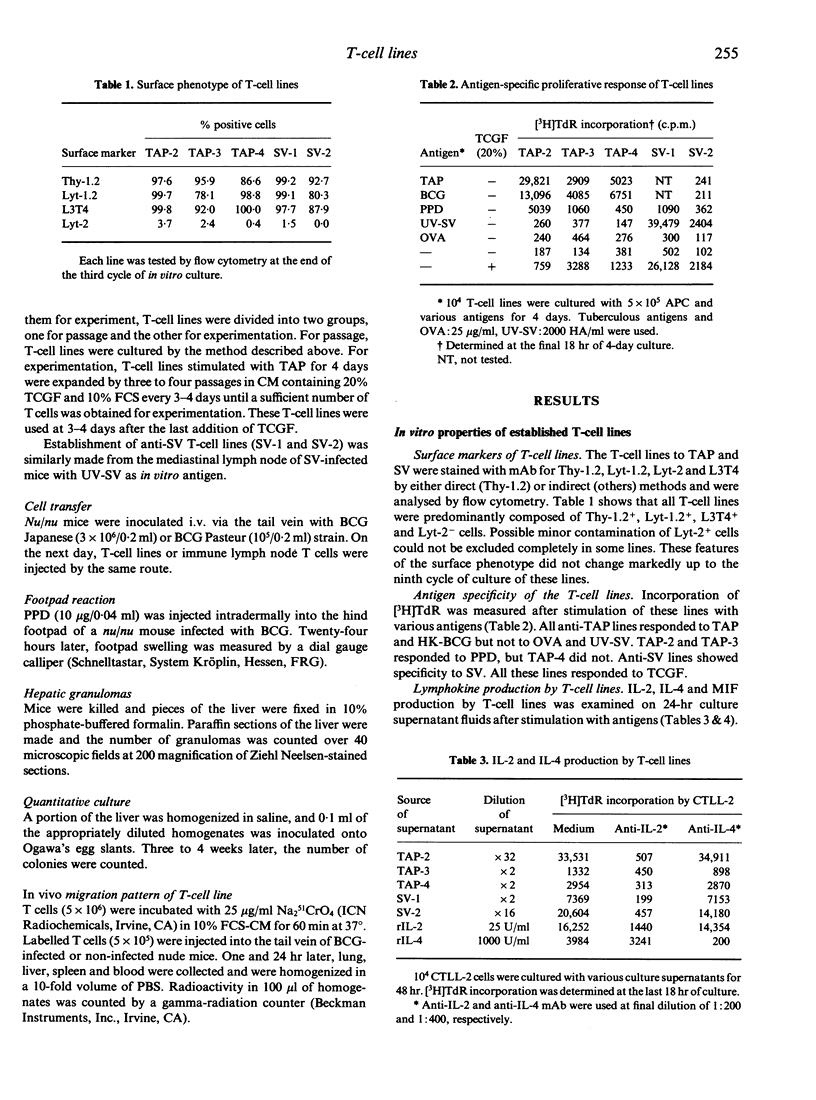Abstract
Tuberculin-active peptide-reactive T-cell lines were established from the popliteal lymph node of BALB/cA mice immunized with heat-killed Mycobacterium tuberculosis to investigate the cellular mechanisms in the protective immunity of tuberculosis. These T-cell lines, consisting mainly of L3T4 surface antigen-positive cells, were transferred intravenously into nude mice infected with M. bovis strain bacillus Calmette-Guérin (BCG). Four or 6 weeks after transfer, footpad swelling and hepatic granuloma formation were observed and viable counts in the liver were decreased. Reduction of viable counts in the liver was obviously preceded by the hepatic granuloma formation. An effect of Lyt-2+ T cells which might be included in the inoculum could be ruled out by the experiment using T-cell lines pretreated with anti-Lyt-2 monoclonal antibody and complement. These results indicated that T cells required for protective immunity in these experiments belong to the L3T4-positive TDTH subset. However, their protective activity was inferior to that of freshly prepared immune lymph node T cells. From the observation of migration patterns of 51Cr-labelled T cells in BCG-infected nude mice, a relatively high proportion of freshly isolated T cells, but only a small part of T-cell line, deposited in the spleen of infected nude mice. This difference in migration pattern of freshly isolated and cultured T cells could be one of the reasons for the less in vivo anti-bacterial activity of the latter.
Full text
PDF






Selected References
These references are in PubMed. This may not be the complete list of references from this article.
- Bookman M. A., Groves E. S., Matis L. A. Expression of MEL-14 antigen is not an absolute requirement for dissemination to lymph nodes after adoptive transfer of murine T lymphocyte clones. J Immunol. 1986 Oct 1;137(7):2107–2114. [PubMed] [Google Scholar]
- Dailey M. O., Fathman C. G., Butcher E. C., Pillemer E., Weissman I. Abnormal migration of T lymphocyte clones. J Immunol. 1982 May;128(5):2134–2136. [PubMed] [Google Scholar]
- Dailey M. O., Gallatin W. M., Weissman I. L. The in vivo behavior of T cell clones: altered migration due to loss of the lymphocyte surface homing receptor. J Mol Cell Immunol. 1985;2(1):27–36. [PubMed] [Google Scholar]
- Emmrich F., Kaufmann S. H. Human T-cell clones with reactivity to Mycobacterium leprae as tools for the characterization of potential vaccines against leprosy. Infect Immun. 1986 Mar;51(3):879–883. doi: 10.1128/iai.51.3.879-883.1986. [DOI] [PMC free article] [PubMed] [Google Scholar]
- Leveton C., Barnass S., Champion B., Lucas S., De Souza B., Nicol M., Banerjee D., Rook G. T-cell-mediated protection of mice against virulent Mycobacterium tuberculosis. Infect Immun. 1989 Feb;57(2):390–395. doi: 10.1128/iai.57.2.390-395.1989. [DOI] [PMC free article] [PubMed] [Google Scholar]
- Mustafa A. S., Kvalheim G., Degre M., Godal T. Mycobacterium bovis BCG-induced human T-cell clones from BCG-vaccinated healthy subjects: antigen specificity and lymphokine production. Infect Immun. 1986 Sep;53(3):491–497. doi: 10.1128/iai.53.3.491-497.1986. [DOI] [PMC free article] [PubMed] [Google Scholar]
- Müller I., Cobbold S. P., Waldmann H., Kaufmann S. H. Impaired resistance to Mycobacterium tuberculosis infection after selective in vivo depletion of L3T4+ and Lyt-2+ T cells. Infect Immun. 1987 Sep;55(9):2037–2041. doi: 10.1128/iai.55.9.2037-2041.1987. [DOI] [PMC free article] [PubMed] [Google Scholar]
- Orme I. M. The kinetics of emergence and loss of mediator T lymphocytes acquired in response to infection with Mycobacterium tuberculosis. J Immunol. 1987 Jan 1;138(1):293–298. [PubMed] [Google Scholar]
- Pedrazzini T., Hug K., Louis J. A. Importance of L3T4+ and Lyt-2+ cells in the immunologic control of infection with Mycobacterium bovis strain bacillus Calmette-Guérin in mice. Assessment by elimination of T cell subsets in vivo. J Immunol. 1987 Sep 15;139(6):2032–2037. [PubMed] [Google Scholar]
- Takeya K., Nomoto K., Muraoka S., Shimotori S., Taniguchi T., Miyake T. Growth of two strains of Mycobacterium bovis (BCG) in athymic mice. J Gen Microbiol. 1977 Jun;100(2):403–405. doi: 10.1099/00221287-100-2-403. [DOI] [PubMed] [Google Scholar]
- Ueda K., Yamazaki S., Saegusa J., Someya S. Progressive and fatal infection with attenuated Mycobacterium bovis (BCG) in nude mice. Jpn J Exp Med. 1978 Dec;48(6):533–543. [PubMed] [Google Scholar]
- Ueda K., Yamazaki S., Yamamoto S., Someya S. Spleen cell transfer induces T cell-dependent granulomas in tuberculous nude mice. J Reticuloendothel Soc. 1982 Jun;31(6):469–478. [PubMed] [Google Scholar]
- Yamamoto S., Iwai H., Ueda K. Establishment of tuberculous antigen-specific T cell line and its effect on hepatic granuloma formation in BCG-infected nude mice. Nihon Juigaku Zasshi. 1988 Feb;50(1):215–225. doi: 10.1292/jvms1939.50.215. [DOI] [PubMed] [Google Scholar]


